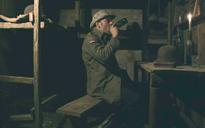WINTER PRAYERS
Is every collector necessarily a murderer? Jean-Paul de Vries, the film’s protagonist, is quite the opposite of a killer. He may not exactly be the one who wakes the dead - but he does try to show that there are other ways to live and deal with life, rather than ‘protect oneself against death’. The objects he painstakingly collects, building his own little private museum like some amateur archaeologist, are like relics or remnants; indexes that point to one thing alone: death, in the form of WWI, the ‘Great War in the Fields of Flanders’. But maybe at the same time de Vries – who, slightly hunchbacked, seems to be eternally digging and scraping the surface of the earth from the former trench war region – also gathers traces of life, objects bearing witness to the fact that in those rotten rat-plagued ditches real men, still boys, were actually living. Shooting and killing, getting shot at and dying, certainly; but breathing, drinking and playing as well; killing time, sculpting things with what was at hand, literary creating objects from scratch. And yet, as we watch de Vries strolling down the woods, digging the hard soil, accompanying fellow ‘warheads’ at some ‘historical’ costume photo-shoot with a ‘French soldier’; as we hear him going on about the link between his own youthful discovery and the youth that died on the front, the ghostly side of (t)his story comes into view. No dead souls are being resurrected. But when we see the collected skeletons, the daily objects these young soldiers used, the bottles they drank, the thousands of white graves at the war cemetery de Vries regularly visits; when we notice how some people seem to continue to identify with (and sometimes, or so it seems, glorify) WWI, it’s not only de Vries’, but our own history that takes form, bearing an individual face.
(Steven Tallon)

- Format HDV(High Definition Video)
- Color system PAL
- Color col.
- Year 2006
- Duration 00:56:30
- Languageinfo
Subtitles: English UK
Spoken: French, Dutch/ Flemish
-
Artists
-
EVENTS